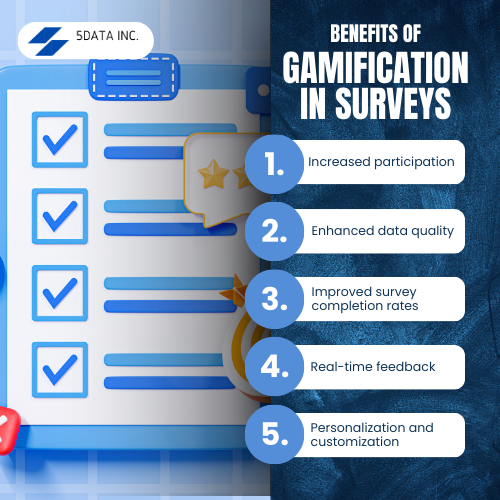Companies can see a real participation boost by adding game elements, crafting engaging questions, and rethinking survey design. Let’s dive deep into how this works and understand why it is a game-changer for user engagement and response rates.
Imagine this: you open a survey, and instead of facing a boring wall of questions, there’s a progress bar ticking up with every answer, a points tally racking up like a game score, or even a fun mini-quiz vibe that tricks you into forgetting it’s a survey at all. That’s the charm of interactive surveys—suddenly, it’s not a drag, it’s a little thrill!
It is so engaging that people don’t just click through to get it over with—they stick around because it’s fun. When they’re having fun, response rates climb, and the quality of data collection improves. It’s a win-win.
What we cover in this blog
Key Takeaways
- Gamification makes surveys interactive and engaging.
- It encourages higher response rates with a fun approach.
- Participants provide more accurate and thoughtful answers.
- A positive experience improves brand perception and loyalty.
Understanding Survey Gamification
So, what exactly is gamification in surveys? It’s about borrowing tricks from games—like challenges, rewards, or storytelling—and blending them into a questionnaire design. Think of it as making a standard form into gamified forms that spark curiosity. Maybe you earn a badge for completing a section, or there’s a leaderboard showing how your input stacks up. These game elements tap into our natural love for competition and achievement. Suddenly, filling out a survey isn’t a chore; it’s a little adventure. This approach becomes the key to unlocking better survey completion numbers and getting richer customer feedback.
Why Businesses Should Embrace Gamified Surveys
1. Increased participation
The market we are in relies on user experience. Do you know what a survey being a pain means? People are leaving faster than you can blink. But, if you make the survey more appealing using survey rewards like discounts or a raffle for something fun, then you have their attention. Incentive surveys not only appeal but also actively engage your audience. Launching a prize draw gamifies the survey there, and the response rates increase. Surprising as it may sound, this is the type of survey strategy that profoundly engages casual survey participants.
2. Enhanced Data quality
Data quality matters, too. When people rush through a survey to finish, you end up with half-baked answers. But gamified forms keep them engaged, so they’re more likely to think about their responses. That’s good for businesses relying on customer feedback to make decisions.
For companies needing help managing information, Data Collection and Data Management Service Providers can help obtain the necessary data.
3. Real-Time Feedback
Traditional surveys often feel like a one-way street—businesses ask, customers answer, end of story. But with survey gamification, it’s a conversation. You’re not just gathering info; you’re building a connection. Clients struggling with low survey completion rates were served with interactive surveys that gave real-time feedback. A substantial jump in responses and a treasure trove of insights that had never been tapped before were measured.
4. Improved Survey Completion Rate
Let’s not forget the role of survey rewards. People love a little something for their time, whether it’s a coupon, a gift card, or even just bragging rights on a leaderboard. These incentives tie into survey motivation in a big way. Folks who’d normally skip a questionnaire dive in because they could unlock a small perk. It’s human nature—we’re wired to chase rewards.
5. Personalization and Customization
Coming up with engaging prompts is a major part of the survey. Don’t endlessly ask bland, monotonous questions such as “Rate us from 1-5.” rather, prefer imagining- “How much strength to your coffee possess to defeat the evil overlord of bland coffee?” Surprising, memorable, and all relative to survey design.
Of course, none of this happens by accident. Building a gamified survey takes thought and a solid grasp of what drives people. That’s where expertise comes in. The top-notch Application Development Services create custom survey platforms that pop. Whether it’s a sleek mobile app or a web-based tool, they tailor the tech to fit the vision. After all, a clunky interface can kill even the best-gamified forms. Smooth, intuitive design paired with game elements is the secret sauce for survey success.
The Best Software Application Development Company can assist businesses looking to level up their digital surveys.

Conclusion
The beauty of this concept is its flexibility. Whether you’re a small startup or a big corporation, survey gamification scales to fit. Digital surveys are already everywhere—why not make them work harder?
It’s about meeting people where they are. Attention spans are short, and patience is thin. If you want feedback, you’ve got to earn it. Gamification in surveys isn’t just a gimmick—it’s a proven way to cut through the noise. So, next time you’re staring at a flat response rate, think about adding a little game to the mix. It might just be the boost you’ve been looking for.
Frequently Asked Questions
1. What is survey gamification, and how does it work?
Survey gamification adds game elements like points, rewards, or challenges to surveys, making them more interactive and fun to increase user engagement and response rates.
2. How can survey rewards improve participation?
Survey rewards, like discounts or prizes, motivate people to complete surveys by offering a tangible incentive, leading to a noticeable participation boost.
3. Why is questionnaire design important in gamified surveys?
A good questionnaire design with engaging questions keeps users interested and ensures the survey feels less like a task, improving survey completion rates.
4. What industries benefit from survey gamification?
From retail to healthcare, any industry needing quality customer feedback can use survey gamification to improve response rates and user experience.

Rasmita Patro
Author
